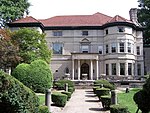East Orange station

East Orange is an active commuter railroad train station in the city of East Orange, Essex County, New Jersey. Located next to East Orange City Hall, the station serves trains on the two lines that make up New Jersey Transit's Morris and Essex Lines: the Morristown Line and Gladstone Branch. Trains heading east to New York Penn Station and Hoboken Terminal stop at Newark Broad Street Station next, while trains heading west towards Gladstone and Hackettstown stop at Brick Church station. East Orange station contains two platforms (one side platform and one island platform) to service three active tracks. The station is accessible for handicapped persons per the Americans with Disabilities Act of 1990. Service in East Orange began on November 19, 1836 when the Morris and Essex Railroad opened to Orange. Originally the station was known as Orange Junction as the name East Orange was assigned to the now-closed Grove Street station to the east. The current station at the location opened on December 18, 1922 when the Delaware, Lackawanna and Western Railroad completed an elevation project of the tracks through the city. The headhouse at East Orange station were added to the New Jersey and National Registers of Historic Places in 1984 as part of the Operating Passenger Railroad Stations Thematic Resource.
Excerpt from the Wikipedia article East Orange station (License: CC BY-SA 3.0, Authors, Images).East Orange station
City Hall Plaza,
Geographical coordinates (GPS) Address Nearby Places Show on map
Geographical coordinates (GPS)
| Latitude | Longitude |
|---|---|
| N 40.761333333333 ° | E -74.210972222222 ° |
Address
City Hall Plaza
City Hall Plaza
07018
New Jersey, United States
Open on Google Maps



